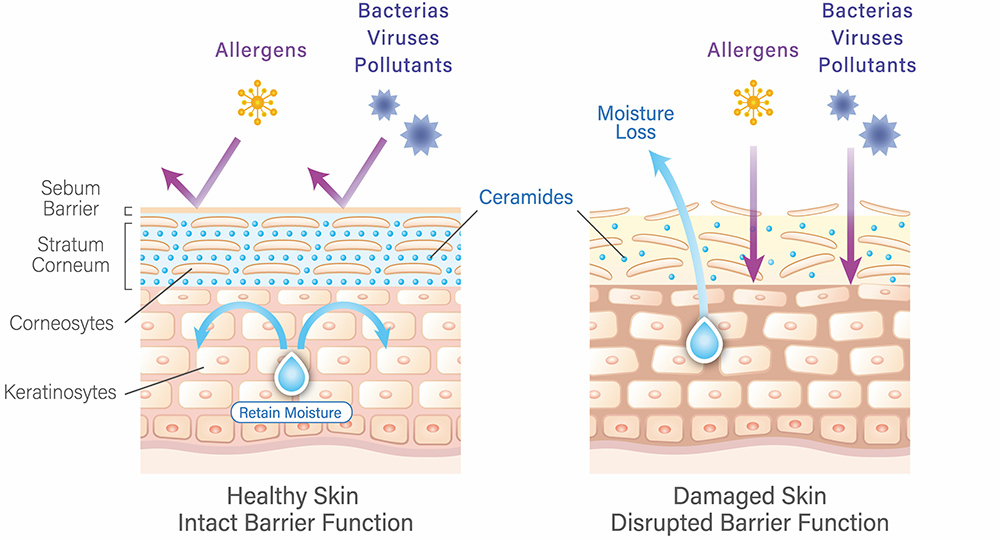Our hands are what define us as people, capable of all those things we do which make us human. But we take our hands for granted until something goes wrong with them. Imagine being in too much pain to send a text, lift a teacup, pick up your child…
Occupational dermatitis can affect your hands to this extent and is far more common than you might imagine. We need to think beyond just gloves.
The scale of the problem:
According to the European Agency for Safety and Health at Work, skin diseases are the second most common work related health problem in Europe. An unbelievable 40% of workers will suffer from a skin issue at some point in their working lives.
The knock-on effect for businesses is enormous:
- Lost working time
- Loss of productivity
- Poor morale
- Increased danger from mishandling due to pain
- Issues with hygiene - cleaning and drying already sore skin
- Cost of welfare compensation claims – The HSE reports that occupational dermatitis accounts for 10% of compensation cases under the Department of Work and Pensions Industrial Injuries Scheme
The effect on workers on top of the pain and discomfort is equally damaging:
- Adverse effect on family and social life
- Cost of ongoing treatment
- Can be career-ending – this is a long term condition: Up to 10 years after the condition first occurs, 50% of workers still have skin problems.
A closer look at the issue - What causes occupational dermatitis?
Work related contact and allergic dermatitis both cause similar types of symptoms: itching, swelling, blistering, weeping, scaling, flaking and cracking. These conditions can cause a disproportionate amount of discomfort and inconvenience when occurring on the hands.
Irritant contact dermatitis
Irritant contact dermatitis is caused by direct contact with irritants, chemical, biological, mechanical or physical, or repeated contact with water. Example irritants are:
- Wet work
- Soaps, shampoos, detergents
- Solvents
- Some foods
- Oils and greases
- Dusts
- Acids and alkalis
- Wet cement
One example of irritant contact dermatitis is actually a consequence of trying to protect the hands. Moisture build-up underneath protective gloves can result in extremely sore and inflamed hands, leaving workers with a dangerous dilemma: remove gloves and place your hands at even more risk, or put gloves on over painful hands, causing even more discomfort and potentially risking fumbling accidents.
Allergic contact dermatitis
Allergic contact dermatitis occurs when the sufferer develops an allergy (becomes sensitised by an exposure). This allergic reaction is likely to become permanent. Example allergens are:
- Hair dyes
- UV cured printing inks
- Adhesives
- Nickel
- Some plants
- Wood dusts
- Rosin (Colophony – from pine tree sap, used in a huge variety of applications)
Occupational dermatitis is preventable, by protecting against the exposure in the first place.
Your Responsibility as Employer:
Management of Health and Safety at Work Regulations (1999) state clearly in sections 3 – 6 that it is not only your responsibility to conduct comprehensive risk assessments but also to monitor health on an ongoing basis and provide suitable effective protective equipment.
When making a risk assessment regarding hand protection, it is difficult to accurately measure the threat to skin from irritants and allergens. This makes it even more important that businesses train their staff in looking after their own health and always taking preventative measures to avoid problems starting in the first place. A clear and simple hand protection programme is the way to do this. After all, prevention is far easier, cheaper and less painful than treatment.
Using skincare to provide a protective barrier:
An effective way to prevent irritants and allergens making contact with the skin is by using a barrier cream for industrial use to form a thin layer on bare skin which will prevent penetration and absorption of contaminants. By maintaining skin barrier integrity, skin hydration is improved and the skin is also able to restore and repair itself.

Part of a full hand protection programme:
While an industrial barrier cream for hands should never be used in place of gloves, it should form a key part of your hand protection programme, as its benefits can be felt even by those wearing gloves. The best industrial barrier cream can protect skin from the build up of moisture underneath gloves which can lead to irritation, inflammation and other unpleasant symptoms of dermatitis.
Choose natural ingredients, proven to be gentle on skin, yet effective:
Many barrier creams for industrial use include synthetic ingredients designed to form a protective layer over the hands – these can sometimes be greasy or occasionally have unpleasant scents. Some which contain petroleum jelly can even cause rubber or latex gloves to deteriorate.
Anchor Safety’s Halker Barrier Balm, a barrier cream for industrial use, is made from natural ingredients, mineral clay and plant extracts to provide a soothing natural barrier which is in tune with your skin, non-greasy and gently moisturising.

Hälker Barrier Balm
Making Hälker Barrier Balm part of an overall industrial hand protection regime could prevent your workforce joining the 84,000 people that the HSE reports as suffering from dermatitis caused or made worse by work. Protecting hands with an industrial hand protection cream before they become sore will increase safety on your site, as well as saving work time and money. And your staff will be able to send that text, pick up that cup of tea and, of course, hug their children.
Order Hälker Barrier BalmIf you have any questions about the most effective way to protect working hands call our protection specialists now, on 0800 328 5028.